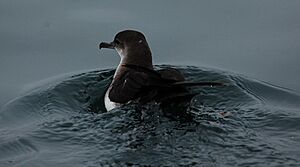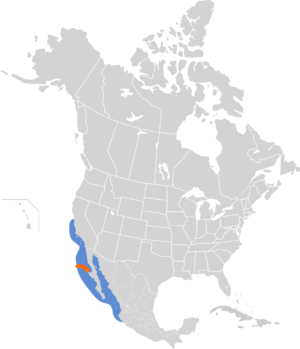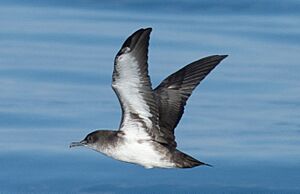Black-vented shearwater facts for kids
Quick facts for kids Black-vented shearwater |
|
|---|---|
 |
|
| Conservation status | |
| Scientific classification | |
| Genus: |
Puffinus
|
| Species: |
opisthomelas
|
 |
|
The black-vented shearwater (Puffinus opisthomelas) is a special type of seabird. It lives only on islands near the Pacific coast of Mexico and in the Gulf of California. This bird is smaller than many other seabirds. It grows to about 30–38 cm long. Its wings can spread up to 76–89 cm wide. It usually weighs around 400 grams. Black-vented shearwaters spend most of their lives out at sea. They mainly eat small fish. These birds are active at night, especially when it's dark.
Contents
What's in a Name?
The name "puffin" might sound familiar. It actually comes from an old English word, "pophyn." This word was used a long time ago to describe young shearwaters. People would prepare them as food. Since shearwaters and Atlantic puffins often nest in the same places, the name "puffin" was accidentally given to the Atlantic puffin. The name stuck for both the Atlantic puffin and the group of birds called Puffinus, which includes the black-vented shearwater.
Family Tree
The black-vented shearwater is one of about 21 different species in the Puffinus family. Eight of these live in North and Middle America. For a long time, the black-vented shearwater was thought to be a type of Manx shearwater. But in 1983, bird experts decided it was its own unique species. It is now considered a "monotypic" species. This means it does not have any different types or subspecies.
How to Spot a Black-Vented Shearwater
Adult black-vented shearwaters are about 30–38 cm long. Their wingspan is 76–89 cm. They weigh around 400 grams. Male birds are usually a little bigger than females. However, the size difference is very small.
Feather Colors
Baby black-vented shearwaters have soft grey feathers. These feathers are lighter around their throat and chest. As they grow, these soft feathers get a bit lighter. Adult birds have dark brown heads and backs. Their bellies are lighter, often white with some brown spots. This color pattern is called countershading. It helps them hide from predators. From above, their dark backs blend with the dark ocean. From below, their light bellies blend with the bright sky. Young birds look similar to adults. Their feathers are often darker and have more contrast. Males and females have the same feather colors.
Losing Feathers
Black-vented shearwaters lose their feathers and grow new ones during their first breeding season. This process is called molting. Scientists think this molting helps them dive better. When their wings are smaller, it might be easier to dive underwater. These birds look for food closer to shore than many other seabirds. So, they don't need super-efficient wings for long flights. Molting might also help them dive more easily when they are raising their chicks.
Where They Live
These birds are called pelagic birds. This means they live in the open ocean. You can find them in the Pacific Ocean and the Gulf of California. They tend to stay closer to land than most other shearwaters.
Nesting Spots
Black-vented shearwaters mostly nest on islands. These islands are off the coast of northern and western Baja California, Mexico. The main nesting island is Isla Natividad. About 95% of the nesting birds live there. Other important islands include Isla de Guadalupe and Islas San Benito. During colder months, you can often see them along the central and southern California coast. Recently, they have also been seen nesting on Isla Rasa and Isla Partida. These islands are in the Gulf of California. This shows their nesting areas are growing. Sometimes, a black-vented shearwater might even be seen as far north as British Columbia. But this is very rare.
Water Preferences
Black-vented shearwaters like warmer waters. They prefer water that is warmer than 14 °C. But they can adapt to different places and ways of finding food. They mostly live in waters over the continental shelf. This is the shallow part of the ocean near land. Near their nesting islands, the ocean floor drops very deep. Some birds are thought to look for food in waters over 2 kilometers deep. These birds do not travel far. They usually stay close to their nesting islands all year.
How They Live
Black-vented shearwaters are nocturnal. This means they are active at night. Their activity depends on how much light there is. Scientists believe they do this to avoid predators. For example, Western gulls hunt during the day. Black-vented shearwaters are most often caught by predators during daylight hours.
Bird Calls
We don't have many recordings of black-vented shearwater calls. But their sounds are described as a moaning growl. Some people say it sounds like a dentist's drill. These birds only call at night. They call when there is little or no moon. Their calls are very important for finding mates. This is because males and females look exactly alike.
What They Eat
Black-vented shearwaters mainly eat small fish. They have been seen eating sardines, herring, anchovies, and a type of squid called Mastegoteuthid squid. They are not attracted to bait thrown from boats. They also don't follow ships for food like some other seabirds.
These birds look for food closer to shore than many other seabirds. They don't usually go on very long trips to find food. Like other birds in the Puffinus family, black-vented shearwaters are great divers. They are the best divers in their family. They can hold their breath for up to 88 seconds. They can dive as deep as 52 meters. They dive even deeper when they are looking for food during their breeding season.
Raising Families
Black-vented shearwaters nest in groups called colonies. We don't know exactly how big these colonies are. But about 95% of their breeding population has always been on Isla Natividad.
During breeding season, these birds dig burrows. They keep these burrows clean all season. We are not sure when they dig them. But studies suggest it's between late November and January. They usually dig burrows in sandy soil. They like areas with low plants. On San Benito Island, shearwaters often nest in cracks in rocks. They will also use burrows that are already made if they can find them.
They usually lay one egg. Sometimes, two eggs are found in a nest. This might happen if another female lays an egg in the same nest. Or one egg might be from a previous season. Both parents take turns sitting on the egg. Each parent sits for about three to five days. The egg hatches after about 49 days.
When chicks hatch, they are very helpless. They cannot keep themselves warm. So, their parents must take very good care of them.
Protecting the Black-Vented Shearwater
In the past, these birds faced dangers from wild cats and other animals on their nesting islands. But these problems have mostly been solved. Now, some birds get caught in fishing nets, especially gill nets. The fishing industry is growing. Because of this, the black-vented shearwater is listed as near threatened by the IUCN. This means they could become endangered if we don't protect them.
All the islands where they nest have people living on them. This human presence has made their nesting areas smaller. On Isla Natividad, building towns and roads has greatly affected their nesting spots. It's estimated that about 26,532 burrows have been lost. This is about 15% of the total colony. However, the birds have started nesting in new areas. This includes Isla Rasa and other islands in the Gulf of California. This is good news for the future of this species.



